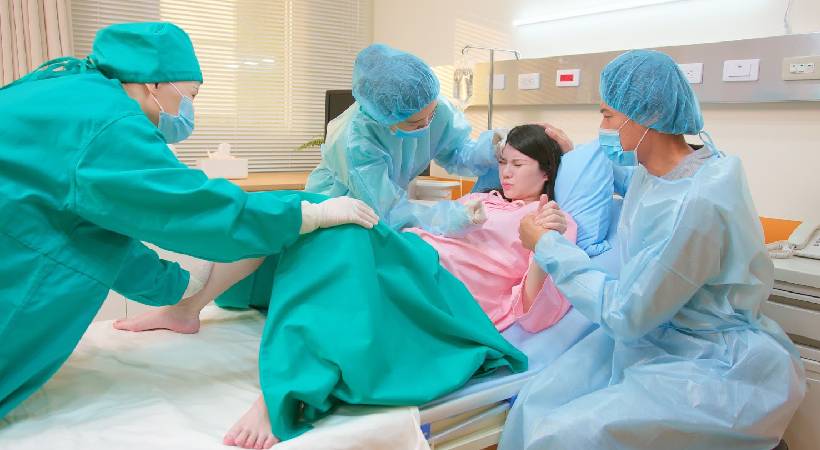Welcome to 0 to 9 Women’s Care & Fertility Center...
Our Services

Introduction
Pelvic organ prolapse (POP) occurs when pelvic organs, such as the uterus, bladder, or rectum, descend due to weakened pelvic floor muscles and connective tissues. Laparoscopic pelvic organ prolapse surgery is a minimally invasive technique to restore normal anatomy and function. Two common procedures are uterine suspension, which repositions the uterus, and sacrocolpopexy, often performed for vaginal vault prolapse after hysterectomy. These surgeries aim to improve quality of life and alleviate symptoms like pelvic pressure, discomfort, and urinary or bowel dysfunction.
Causes
Pelvic organ prolapse is caused by a combination of factors, including:
- Childbirth: Vaginal delivery can stretch and weaken the pelvic floor.
- Aging: Loss of tissue elasticity with age.
- Hormonal Changes: Decreased estrogen after menopause weakens connective tissue.
- Chronic Strain: Repeated heavy lifting, constipation, or chronic coughing.
- Genetics: Family history of prolapse or weak connective tissue.
- Previous Pelvic Surgery: Especially hysterectomy or pelvic floor repairs.
- Obesity: Increased pressure on the pelvic floor.
Symptoms
Symptoms of pelvic organ prolapse vary depending on the severity and organ involved:
- Sensation of heaviness or pressure in the pelvis.
- Bulge or tissue protruding from the vaginal opening.
- Difficulty with urination or bowel movements.
- Incomplete bladder emptying or frequent urinary tract infections (UTIs).
- Discomfort during intercourse.
- Lower back pain or groin discomfort.
Diagnosis
- Medical History: Assessing symptoms, risk factors, and previous surgeries.
- Physical Examination:
- Pelvic exam to evaluate the degree of prolapse.
- Use of the Valsalva maneuver to observe organ descent.
- Imaging Studies:
- Ultrasound: To visualize prolapsed organs.
- MRI: For detailed pelvic anatomy, if needed.
- Urodynamic Testing: For patients with urinary symptoms.
Treatment
Surgical Options:
Laparoscopic Uterine Suspension:
- What it is: A procedure to lift and support the uterus using sutures or mesh.
- How it’s done:
- Small incisions are made in the abdomen.
- The uterus is repositioned and anchored to strong pelvic ligaments or the sacrum.
- Indications: Mild to moderate uterine prolapse in women wishing to preserve their uterus.
Laparoscopic Sacrocolpopexy:
- What it is: Surgical repair of vaginal vault prolapse by attaching the vaginal apex to the sacral promontory using mesh.
- How it’s done:
- Through laparoscopic incisions, a surgical mesh is placed to restore vaginal position and support.
- It is considered the gold standard for vaginal vault prolapse repair.
- Indications: Severe prolapse, often post-hysterectomy.
Post-Operative Care
- Recovery:
- Most patients resume normal activities in 2–4 weeks.
- Avoid heavy lifting or strenuous activities for 6–8 weeks.
- Pain Management: Use of prescribed medications or over-the-counter analgesics.
- Pelvic Floor Therapy: Strengthening exercises like Kegels may be recommended.
- Follow-Up: Regular check-ups to monitor healing and evaluate surgical success.
Risks
- Infection or Bleeding: Minimal due to laparoscopic technique.
- Mesh Complications: Rare cases of mesh erosion or pain.
- Recurrence: Prolapse may recur if underlying causes persist.
- Injury to Surrounding Organs: Bladder, bowel, or ureter injury (rare).
Conclusion
Laparoscopic pelvic organ prolapse surgeries, such as uterine suspension and sacrocolpopexy, are effective and minimally invasive options for restoring pelvic anatomy and alleviating prolapse symptoms. These procedures offer long-lasting results, improved quality of life, and faster recovery times. Patients should consult their gynecologist or urogynecologist to discuss individualized treatment plans, including surgical and non-surgical options.
We’d love to hear from you !
Our Gallery








Unveiling New Horizons in Fertility, One Article at a Time
🌸 Tips for a Healthy Pregnancy –
Pregnancy is one of the most beautiful journeys in a...
When Your Clock is Off: Understanding and
A woman’s menstrual cycle is often described as a perfect...
4 Lifestyle Factors That Influence Fertility
When it comes to improving fertility and achieving a healthy...




